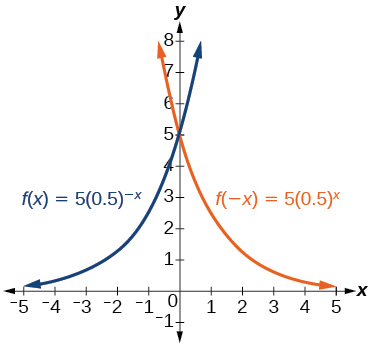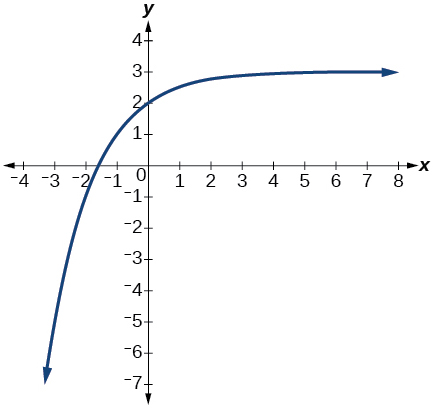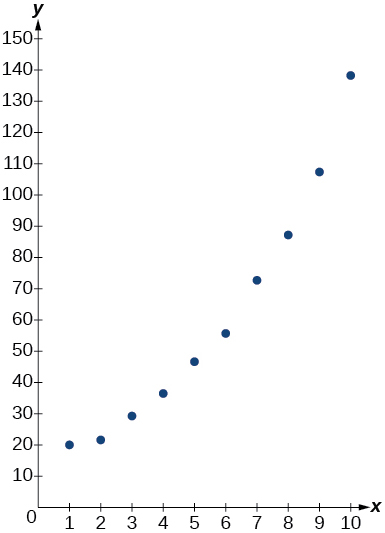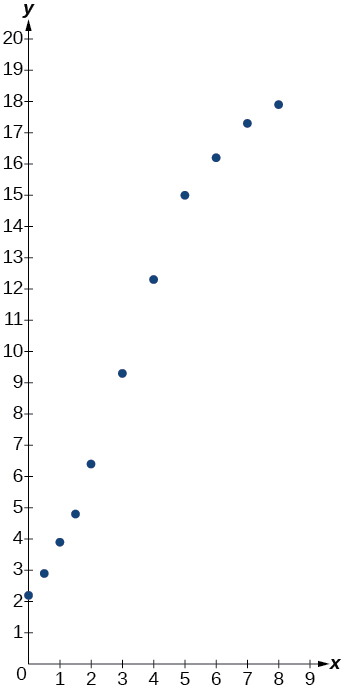Chapter 6 Exponential and Logarithmic Functions
Chapter 6 Practice Test
Practice Test
- The population of a pod of bottlenose dolphins is modeled by the function[latex]\,A\left(t\right)=8{\left(1.17\right)}^{t},[/latex] where[latex]\,t\,[/latex]is given in years. To the nearest whole number, what will the pod population be after[latex]\,3\,[/latex]years?
Show Solution
About[latex]\,13\,[/latex]dolphins.
- Find an exponential equation that passes through the points[latex]\,\text{(0, 4)}\,[/latex]and[latex]\,\text{(2, 9)}\text{.}[/latex]
- Drew wants to save $2,500 to go to the next World Cup. To the nearest dollar, how much will he need to invest in an account now with[latex]\,6.25%\,[/latex]APR, compounding daily, in order to reach his goal in[latex]\,4\,[/latex]years?
Show Solution
[latex]$1,947[/latex]
- An investment account was opened with an initial deposit of $9,600 and earns[latex]\,7.4%\,[/latex]interest, compounded continuously. How much will the account be worth after[latex]\,15\,[/latex]years?
- Graph the function[latex]\,f\left(x\right)=5{\left(0.5\right)}^{-x}\,[/latex]and its reflection across the y-axis on the same axes, and give the y-intercept.
Show Solution
y-intercept:[latex]\,\left(0,\text{ 5}\right)[/latex]

- The graph shows transformations of the graph of[latex]\,f\left(x\right)={\left(\frac{1}{2}\right)}^{x}.\,[/latex]What is the equation for the transformation?

- Rewrite[latex]\,{\mathrm{log}}_{8.5}\left(614.125\right)=a\,[/latex]as an equivalent exponential equation.
Show Solution
[latex]{8.5}^{a}=614.125[/latex]
- Rewrite[latex]\,{e}^{\frac{1}{2}}=m\,[/latex]as an equivalent logarithmic equation.
- Solve for[latex]\,x\,[/latex]by converting the logarithmic equation[latex]\,lo{g}_{\frac{1}{7}}\left(x\right)=2\,[/latex]to exponential form.
Show Solution
[latex]x={\left(\frac{1}{7}\right)}^{2}=\frac{1}{49}[/latex]
- Evaluate[latex]\,\mathrm{log}\left(\text{10,000,000}\right)\,[/latex]without using a calculator.
- Evaluate[latex]\,\mathrm{ln}\left(0.716\right)\,[/latex]using a calculator. Round to the nearest thousandth.
Show Solution
[latex]\mathrm{ln}\left(0.716\right)\approx -0.334[/latex]
- Graph the function[latex]\,g\left(x\right)=\mathrm{log}\left(12-6x\right)+3.[/latex]
- State the domain, vertical asymptote, and end behavior of the function[latex]\,f\left(x\right)={\mathrm{log}}_{5}\left(39-13x\right)+7.[/latex]
Show Solution
Domain:[latex]\,x3;\,[/latex]Vertical asymptote:[latex]\,x=3;\,[/latex]End behavior:[latex]\,x\to {3}^{-},f\left(x\right)\to -\infty \,[/latex]and[latex]\,x\to -\infty ,f\left(x\right)\to \infty[/latex]
- Rewrite[latex]\,\mathrm{log}\left(17a\cdot 2b\right)\,[/latex]as a sum.
- Rewrite[latex]\,{\mathrm{log}}_{t}\left(96\right)-{\mathrm{log}}_{t}\left(8\right)\,[/latex]in compact form.
Show Solution
[latex]{\mathrm{log}}_{t}\left(12\right)[/latex]
- Rewrite[latex]\,{\mathrm{log}}_{8}\left({a}^{\frac{1}{b}}\right)\,[/latex]as a product.
- Use properties of logarithm to expand[latex]\,\mathrm{ln}\left({y}^{3}{z}^{2}\cdot \sqrt[3]{x-4}\right).[/latex]
Show Solution
[latex]3\,\,\mathrm{ln}\left(y\right)+2\mathrm{ln}\left(z\right)+\frac{\mathrm{ln}\left(x-4\right)}{3}[/latex]
- Condense the expression[latex]\,4\mathrm{ln}\left(c\right)+\mathrm{ln}\left(d\right)+\frac{\mathrm{ln}\left(a\right)}{3}+\frac{\mathrm{ln}\left(b+3\right)}{3}\,[/latex]to a single logarithm.
- Rewrite[latex]\,{16}^{3x-5}=1000\,[/latex]as a logarithm. Then apply the change of base formula to solve for[latex]\,x\,[/latex]using the natural log. Round to the nearest thousandth.
Show Solution
[latex]x=\frac{\frac{\mathrm{ln}\left(1000\right)}{\mathrm{ln}\left(16\right)}+5}{3}\approx 2.497[/latex]
- Solve[latex]\,{\left(\frac{1}{81}\right)}^{x}\cdot \frac{1}{243}={\left(\frac{1}{9}\right)}^{-3x-1}\,[/latex]by rewriting each side with a common base.
- Use logarithms to find the exact solution for[latex]\,-9{e}^{10a-8}-5=-41[/latex]. If there is no solution, write no solution.
Show Solution
[latex]a=\frac{\mathrm{ln}\left(4\right)+8}{10}[/latex]
- Find the exact solution for[latex]\,10{e}^{4x+2}+5=56.\,[/latex]If there is no solution, write no solution.
- Find the exact solution for[latex]\,-5{e}^{-4x-1}-4=64.\,[/latex]If there is no solution, write no solution.
Show Solution
no solution
- Find the exact solution for[latex]\,{2}^{x-3}={6}^{2x-1}.\,[/latex]If there is no solution, write no solution.
- Find the exact solution for[latex]\,{e}^{2x}-{e}^{x}-72=0.\,[/latex]If there is no solution, write no solution.
Show Solution
[latex]x=\mathrm{ln}\left(9\right)[/latex]
- Use the definition of a logarithm to find the exact solution for[latex]\,4\mathrm{log}\left(2n\right)-7=-11[/latex]
- Use the one-to-one property of logarithms to find an exact solution for[latex]\,\mathrm{log}\left(4{x}^{2}-10\right)+\mathrm{log}\left(3\right)=\mathrm{log}\left(51\right)\,[/latex]If there is no solution, write no solution.
Show Solution
[latex]x=±\frac{3\sqrt{3}}{2}[/latex]
- The formula for measuring sound intensity in decibels[latex]\,D\,[/latex]is defined by the equation[latex]\,D=10\mathrm{log}\left(\frac{I}{{I}_{0}}\right),[/latex]where[latex]\,I\,[/latex]is the intensity of the sound in watts per square meter and[latex]\,{I}_{0}={10}^{-12}\,[/latex]is the lowest level of sound that the average person can hear. How many decibels are emitted from a rock concert with a sound intensity of[latex]\,4.7\cdot {10}^{-1}\,[/latex]watts per square meter?
- A radiation safety officer is working with[latex]\,112\,[/latex]grams of a radioactive substance. After[latex]\,17\,[/latex]days, the sample has decayed to[latex]\,80\,[/latex]grams. Rounding to five significant digits, write an exponential equation representing this situation. To the nearest day, what is the half-life of this substance?
Show Solution
[latex]f\left(t\right)=112{e}^{-.019792t};[/latex] half-life: about[latex]\,35\,[/latex] days
- Write the formula found in the previous exercise as an equivalent equation with base[latex]\,e.\,[/latex]Express the exponent to five significant digits.
- A bottle of soda with a temperature of[latex]\,\text{71°}\,[/latex]Fahrenheit was taken off a shelf and placed in a refrigerator with an internal temperature of[latex]\,\text{35° F}\text{.}\,[/latex]After ten minutes, the internal temperature of the soda was[latex]\,\text{63° F}\text{.}\,[/latex]Use Newton’s Law of Cooling to write a formula that models this situation. To the nearest degree, what will the temperature of the soda be after one hour?
Show Solution
[latex]T\left(t\right)=36{e}^{-0.025131t}+35;T\left(60\right)\approx {43}^{\text{o}}\text{F}[/latex]
-
- The population of a wildlife habitat is modeled by the equation[latex]\,P\left(t\right)=\frac{360}{1+6.2{e}^{-0.35t}},[/latex] where[latex]\,t\,[/latex]is given in years. How many animals were originally transported to the habitat? How many years will it take before the habitat reaches half its capacity?
Enter the data from the Table in #33 into a graphing calculator and graph the resulting scatter plot. Determine whether the data from the table would likely represent a function that is linear, exponential, or logarithmic.
| x | f(x) |
| 1 | 3 |
| 2 | 8.55 |
| 3 | 11.79 |
| 4 | 14.09 |
| 5 | 15.88 |
| 6 | 17.33 |
| 7 | 18.57 |
| 8 | 19.64 |
| 9 | 20.58 |
| 10 | 21.42 |
Show Solution
logarithmic

- The population of a lake of fish is modeled by the logistic equation[latex]\,P\left(t\right)=\frac{16,120}{1+25{e}^{-0.75t}},[/latex] where[latex]\,t\,[/latex]is time in years. To the nearest hundredth, how many years will it take the lake to reach[latex]\,80%\,[/latex]of its carrying capacity?
For the following exercises, use a graphing utility to create a scatter diagram of the data given in the table. Observe the shape of the scatter diagram to determine whether the data is best described by an exponential, logarithmic, or logistic model. Then use the appropriate regression feature to find an equation that models the data. When necessary, round values to five decimal places.
| x | f(x) |
| 1 | 20 |
| 2 | 21.6 |
| 3 | 29.2 |
| 4 | 36.4 |
| 5 | 46.6 |
| 6 | 55.7 |
| 7 | 72.6 |
| 8 | 87.1 |
| 9 | 107.2 |
| 10 | 138.1 |
Show Solution
exponential;[latex]\,y=15.10062{\left(1.24621\right)}^{x}[/latex]

| x | f(x) |
| 3 | 13.98 |
| 4 | 17.84 |
| 5 | 20.01 |
| 6 | 22.7 |
| 7 | 24.1 |
| 8 | 26.15 |
| 9 | 27.37 |
| 10 | 28.38 |
| 11 | 29.97 |
| 12 | 31.07 |
| 13 | 31.43 |
| x | f(x) |
| 0 | 2.2 |
| 0.5 | 2.9 |
| 1 | 3.9 |
| 1.5 | 4.8 |
| 2 | 6.4 |
| 3 | 9.3 |
| 4 | 12.3 |
| 5 | 15 |
| 6 | 16.2 |
| 7 | 17.3 |
| 8 | 17.9 |
Show Solution
logistic;[latex]\,y=\frac{18.41659}{1+7.54644{e}^{-0.68375x}}[/latex]

Media Attributions
- Chapter 6 Practice Test #5 © OpenStax College Algebra and Trigonometry is licensed under a CC BY (Attribution) license
- Chapter 6 Practice Test #6 © OpenStax College Algebra and Trigonometry is licensed under a CC BY (Attribution) license
- Chapter 6 Practice Test #33 © OpenStax College Algebra and Trigonometry is licensed under a CC BY (Attribution) license
- Chapter 6 Practice Test #35 © OpenStax College Algebra and Trigonometry is licensed under a CC BY (Attribution) license
- Chapter 6 Practice Test #37 © OpenStax College Algebra and Trigonometry is licensed under a CC BY (Attribution) license

